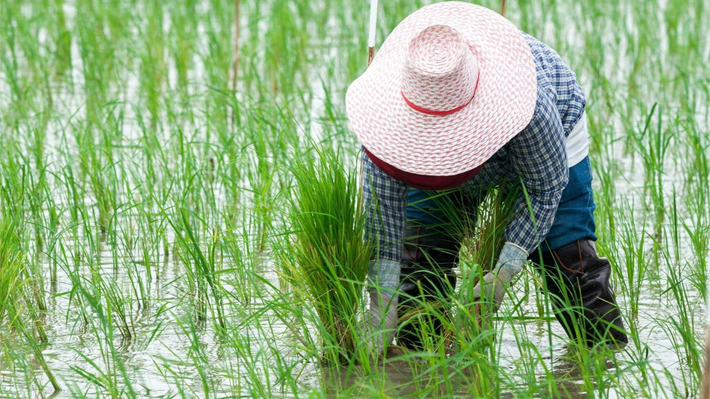Transplanting rice seedlings when they are very young and spacing them farther apart on a regular grid rather than randomly. Land preparation for rice farming involves plowing and harrowing to till or dig-up mix and level the soil.
Rice Farming Up To Twice As Bad For Climate Change As Previously Thought Study Reveals The Independent The Independent
For rice plants to be more productive they need to have.

How to improve rice farming. Filipino melon grower Denis Miguel was intrigued to hear of a young Indian farmer who in 2011. But rice is most susceptible to climate change. Innovative technologies such as hybrid rice New Plant Types and possibly transgenic rice can play an important role in raising the yield ceiling in rice production thus increasing its productivity.
Assessing the demand for water used to cultivate rice and methods for decreasing that water demand could help save hundreds of millions of gallons. The rice field will not be left idle after harvesting and before planting rice. It can accept maximum 42C temperature.
Increase organic matters in soil by growing leguminous crops. With SFC farmers can grow rice in dry fields with simple drip irrigation. With a proper filed management practices and irrigation facility rice farming would be profitable in a short period of time.
Hear the full solution pitch. A ny changes in climate will increase the uncertainty in rice production. Reducing this yield gap may be partly achieved through the introduction and dissemination of good agricultural practices GAP.
By doing this there is less crowding root systems are stronger and farmers can use manual weeders. Tillage helps with weed control and also allows the seeds to be planted at the right depth. Growers may apply organic matters into the rice field for soil improvement frequently.
The three factors that could contribute to increased rice productivity are. We conducted 18 farmer-managed on-farm trials in Tanzania to. In Tanzania the rice yield gap is as high as 87 due to a combination of production constraints and sub-optimal crop management.
Using integrated pest management instead of herbicides. In India rice is cultivated in Rabi and Kharif seasons. And c reducing the post-harvest losses and improving grain quality to enhance profitability.
Pick a location that receives full sunlight as rice grows best with bright light and warm temperatures of at least 70 Fahrenheit approximately 21 Celsius. It is estimated that the production of 1 kg of rice grain requires between 800 to 5000 liters of water. Also in many countries the gaps between yields obtained at research stations and farmers fields still exist.
In Bangladesh Rice is very import ant because it is the staple diet in our country and half of rural population is involved in its farming. B minimizing the yield gap between what is currently harvested by farmers and the achievable highest on-farm yield of varieties they grow. An unconventional method for growing rice has been found to increase yields by 20 to 50 percent.
There are many varieties of rice cultivated across India. A farmworker in a rice paddy field in Ahmedabed India. Rice productivity and net income are increased that will lift more Thai rice growers out of their debt trap.
Mid-season drainage and alternate wetting and drying improve aerobic conditions. Rice can be used to produce Rice bran oil from its husk apart from using in regular culinary purpose. Rice cultivation is convenient for the area which has an abundant water supply prolonged sunshine and high humid land is available.
Thus producing more rice at lower environmental cost is required for future development ie the use of less water and the production of fewer greenhouse gas GHG per unit of rice. But not everyone is on board. More tillers per plant More fertile tillers panicles which form from the tillers that a plant puts out More grains per fertile tiller and Larger grains.
Generally Rice requires hot and humid climatic conditions for its well grow. Rice farming requires 20C to 40C temperature throughout the life period of the crop. There are four general techniques best used in combination to improve rice production and reduce emissions.
Green and Seed a Coastal Communities Solver has developed Seed Film Cultivation SFC an innovative system that increases the sustainability of rice farming. To enhance capacity of participating farmers and other rice stakeholders while pushing the rice farming towards the sustainability level. If rice plants are spread out and not planted very.
The conventional method of rice production involves vast amounts of water. A developing new rice varieties including hybrids with higher yield potential. A New Farming Technique Using Drastically Less Water Is Catching On.
Rice is an increasingly important commodity in sub-Saharan Africa. Rice production needs to increase to. Consider the season your area.
More balanced application of nutrients reduces methane emissions while supporting yields. And then you have to level the surface for reducing the amount of water wasted by uneven pockets of too-deep water or exposed soil.
Improving Rice Production Sense Sustainability
Promoting Sustainable And Inclusive Rice Value Chain In Indonesia Rikolto In Indonesia
Rice Production Under Climate Change Innovation News Network
Improved Rice Cultivation Natural Climate Solutions Nature4climate
Paddy Rice Production Climate Clean Air Coalition
Thailand Supporting Small Rice Farms And Protecting The Environment
How India S Rice Production Can Adapt To Climate Change Challenges
Un Agriculture Agency Takes Step To Help Rice Farmers Bolster Production Un News
How Technology Improves Rice Production Worldwide The Borgen Project



0 comments:
Post a Comment